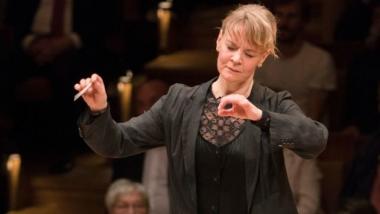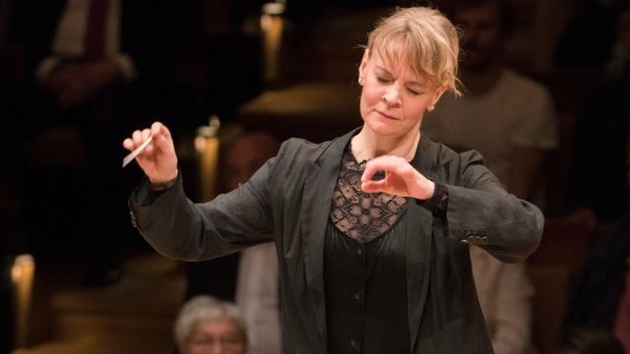
The late British composer Oliver Knussen (who was born in 1952 and passed away in 2018) played a big role in the contemporary music scene of Los Angeles — musically and physically (he was a fellow the size of Smokey Bear with a great bushy beard).
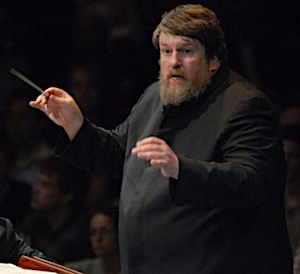
His symphonic and chamber music often found its way onto Los Angeles Philharmonic programs conducted by Esa-Pekka Salonen and in the Green Umbrella series. His 1980 opera, Where the Wild Things Are, based on the children’s book by Maurice Sendak, was staged by LA Opera in 1990. He was also a regular at the Ojai Music Festival.
This past weekend, the LA Phil under the energizing direction of Susanna Mälkki performed a Knussen double bill. It began with his short, sparkle-plenty ditty, Flourish with Fireworks, initially commissioned to celebrate Michael Tilson Thomas’s inaugural season with the London Symphony Orchestra in 1988.
Knussen’s Fireworks, like Stravinsky’s, paints a musical portrait of ascending (multiple-flute) rockets that burst into percussive, brassy arrays of color. Cleverly, Knussen’s fireworks show also celebrates the quiet moments of anticipation between the crowd-pleasing bursts of rockets. Just four minutes in length, it is a skillfully constructed big experience in miniature.
The fireworks, however, did not stop there. The opener was followed by the pyrotechnics of Knussen’s Violin Concerto, in a virtuoso performance (from memory) by Leila Josefowicz. It was something of an encore, since Josefowicz performed the LA Phil premiere of the concerto with Salonen conducting in 2002.
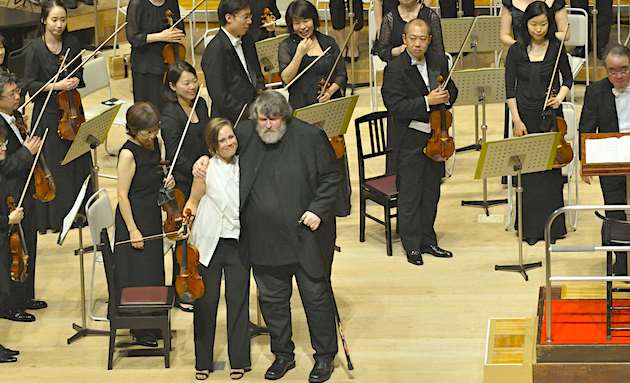
It’s been said that Knussen was such an extreme critic of his creations, he threw away a lot more music than he sent to his publisher. He was the compositional equivalent of a master carpenter who is only satisfied when every note, harmony, and construction fit together like perfect joinery. His music tends toward a bold sense of color that is balanced by a skillful combination of solidity and fragility.
The Violin Concerto represents an exquisite example. Though only 20 minutes in length, it seamlessly transitions between three distinctly defined sections — a showy Recitative, a shadowy Aria, and a romping Gigue.
Originally commissioned by the Pittsburgh Symphony and dedicated to Pinchas Zukerman (who performed the premiere in 2002), the concerto is a remarkable balancing act — an emotionally evolving landscape, an intricate clockwork of contrasting musical temperaments.
In his descriptions of the concerto, Knussen suggests the image of a high-wire act in which the violinist must thread a fine and perilous line between two points represented by the high notes on the violin that begin and end the work.
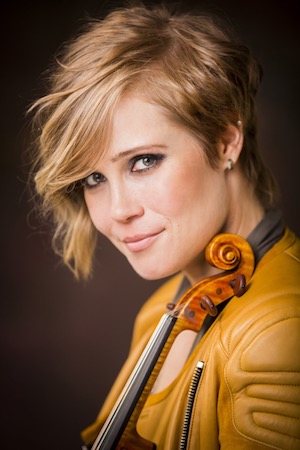
If there was ever a performer that clearly enjoys the thrill of a high-wire performance, it’s Josefowicz. And as her career has evolved, she mostly parted company with the classics, choosing instead to make contemporary works the mainstays of her repertory. She has premiered and commissioned concertos by Esa-Pekka Salonen, Steven Mackey, Helen Grime, Colin Matthews, and recently John Adams’s Scheherazade 2. She was also the featured soloist when the LA Phil performed the Knussen Violin Concerto for the first time (Oct. 15, 2005), with Salonen conducting.
According to her bio, Josefowicz has performed Knussen’s concerto more than 30 times. Even so, her performance Saturday displayed the type of thrill (and potential danger) usually equated with a performance by Cirque du Soleil.
The violin enters in a glittering spotlight, a single elongated high note suspended above a landscape of tolling bells. There is little attempt at blending with the orchestra in the opening “Recitative.” And while there are passages of melodic, harmonic interaction, there is never any question who the star of this show is, which is exactly how Josefowicz played it, combining ferocity and aggressive attacks with exquisite poise and the twirling balance of a ballerina.
In the central, slow movement “Aria,” the mood and the instrumental landscape changes entirely. The strings create a shadow-dominated realm of translucent washes. The winds glitter like stars as the solo violin (like the Firebird) soars in, out, and around.
Of the final section Knussen writes, “Like its antique namesakes, this Gigue is firmly rooted in dancing triple meter, though frequently tripped up with cross meters ... This is a relentlessly driven sort of dance.”
In past performances, Mälkki and Josefowicz have shared many a dance. Saturday the Knussen concerto provided them with perfect choreography.
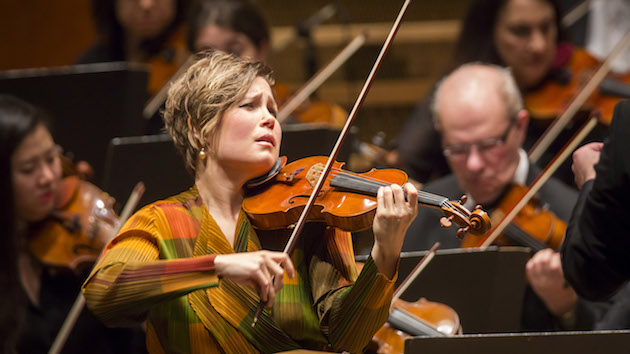
Compared to the clockwork precision of the concerto, Beethoven’s Third Symphony, which followed the intermission, seemed like an unfair fight card — a dancing welterweight versus a hard-hitting heavyweight.
But Mälkki and Philharmonic (clearly well rested after their long tour) brought a bright, buoyant sense of energy to the symphony. In the end, the two compositions were well matched, each representing a musical world — one heroic and panoramic, the other as precise and faceted as a Faberge egg.

